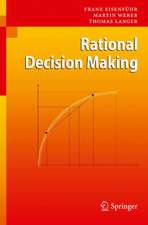Risk Analysis and Human Behavior: Earthscan Risk in Society
Autor Baruch Fischhoffen Limba Engleză Hardback – 16 dec 2011
| Toate formatele și edițiile | Preț | Express |
|---|---|---|
| Paperback (1) | 497.92 lei 6-8 săpt. | |
| Taylor & Francis – 16 dec 2011 | 497.92 lei 6-8 săpt. | |
| Hardback (1) | 1042.68 lei 6-8 săpt. | |
| Taylor & Francis – 16 dec 2011 | 1042.68 lei 6-8 săpt. |
Din seria Earthscan Risk in Society
-
 Preț: 317.61 lei
Preț: 317.61 lei -
 Preț: 346.17 lei
Preț: 346.17 lei -
 Preț: 310.31 lei
Preț: 310.31 lei -
 Preț: 372.90 lei
Preț: 372.90 lei -
 Preț: 300.41 lei
Preț: 300.41 lei - 12%
 Preț: 325.84 lei
Preț: 325.84 lei -
 Preț: 376.70 lei
Preț: 376.70 lei - 14%
 Preț: 329.14 lei
Preț: 329.14 lei - 16%
 Preț: 274.06 lei
Preț: 274.06 lei -
 Preț: 410.46 lei
Preț: 410.46 lei -
 Preț: 452.31 lei
Preț: 452.31 lei -
 Preț: 416.09 lei
Preț: 416.09 lei - 22%
 Preț: 323.32 lei
Preț: 323.32 lei -
 Preț: 416.22 lei
Preț: 416.22 lei -
 Preț: 347.80 lei
Preț: 347.80 lei - 17%
 Preț: 258.30 lei
Preț: 258.30 lei -
 Preț: 197.69 lei
Preț: 197.69 lei - 15%
 Preț: 705.64 lei
Preț: 705.64 lei - 15%
 Preț: 431.25 lei
Preț: 431.25 lei - 18%
 Preț: 1119.52 lei
Preț: 1119.52 lei -
 Preț: 497.92 lei
Preț: 497.92 lei - 18%
 Preț: 1008.48 lei
Preț: 1008.48 lei -
 Preț: 448.38 lei
Preț: 448.38 lei - 15%
 Preț: 435.36 lei
Preț: 435.36 lei -
 Preț: 416.22 lei
Preț: 416.22 lei - 18%
 Preț: 1003.12 lei
Preț: 1003.12 lei -
 Preț: 409.48 lei
Preț: 409.48 lei - 25%
 Preț: 683.99 lei
Preț: 683.99 lei -
 Preț: 451.36 lei
Preț: 451.36 lei -
 Preț: 391.34 lei
Preț: 391.34 lei - 26%
 Preț: 765.45 lei
Preț: 765.45 lei -
 Preț: 448.86 lei
Preț: 448.86 lei
Preț: 1042.68 lei
Preț vechi: 1404.28 lei
-26% Nou
Puncte Express: 1564
Preț estimativ în valută:
199.52€ • 208.74$ • 165.74£
199.52€ • 208.74$ • 165.74£
Carte tipărită la comandă
Livrare economică 03-17 aprilie
Preluare comenzi: 021 569.72.76
Specificații
ISBN-13: 9781849714426
ISBN-10: 1849714428
Pagini: 432
Dimensiuni: 156 x 234 x 28 mm
Greutate: 0.46 kg
Ediția:1
Editura: Taylor & Francis
Colecția Routledge
Seria Earthscan Risk in Society
Locul publicării:Oxford, United Kingdom
ISBN-10: 1849714428
Pagini: 432
Dimensiuni: 156 x 234 x 28 mm
Greutate: 0.46 kg
Ediția:1
Editura: Taylor & Francis
Colecția Routledge
Seria Earthscan Risk in Society
Locul publicării:Oxford, United Kingdom
Public țintă
Postgraduate, Professional, and UndergraduateCuprins
Introduction Section 1: Overview 1. Risk Perception and Communication 2. Cognitive Processes in Stated Preference Methods Section 2: Behaviorally Realistic Risk Analysis 3. Cost-benefit Analysis and the Art of Motorcycle Maintenance 4. Individuals’ Decisions Affecting Radiation Exposure After a Nuclear Event 5. Predicting Emergency Evacuation and Sheltering Behavior: A Structured Analytical Approach 6. An Integrative Approach to Label Design and Evaluation 7. Analyzing Disaster Risks and Plans: An Avian Flu Example Section 3: Social Context of Behavioral Research 8. Lay Foibles and Expert Fables in Judgments about Risk 9. Risk Perception and Communication Unplugged: Twenty Years of Process 10. Non-persuasive Communication about Matters of Greatest Urgency: Climate Change Section 4: Risk Communication 11. What Forecasts (seem to) Mean 12. Patients’ Vaccination Comprehension and Decisions 13. Development and Evaluation of an HIV/AIDS Knowledge Measure for Adolescents Focusing on Misconceptions 14. Communicating about Xenotransplanation: Models and Scenarios Section 5: Aiding Individual Risk Decisions 15. What do Patients Want? Help in Making Effective Choices 16. Giving Advice: Decision Theory Perspectives on Sexual Assault 17. Sticky Decisions: Peanut Butter in a time of Salmonella Section 6: Aiding Public Risk Decisions 18. A Multi-channel Stakeholder Consultation Process for Energy Deregulation 19. The Science and Practice of Risk Ranking 20. Counting Casualties: A Framework for Respectful, Useful Records. Postscript: Integrating Risk Analysis and Behavioral Research
Notă biografică
Baruch Fischhoff is Howard Heinz University Professor, Carnegie Mellon University, US, Department of Social and Decision Sciences, Department of Engineering and Public Policy.
Descriere
The articles collected here are foundational contributions to incorporating behavioural research in risk analysis. On the one hand, they address the questions of how to communicate with the public about risks, learning about the public’s concern and addressing them with responsive risk management and authoritative communications. On the other hand, they address the questions of how to ensure that risk analyses make realistic assumptions about how people will behave, when they are part of risky systems, and what role expert judgment plays in analytical results. Ensuring behaviourally realistic risk analysis has been a central mission of the author’s career and here he achieves the clarity long sought for. These articles touch on each fundamental area, demonstrating the possibilities for collaborative applied research and the basic research that it impels.


























